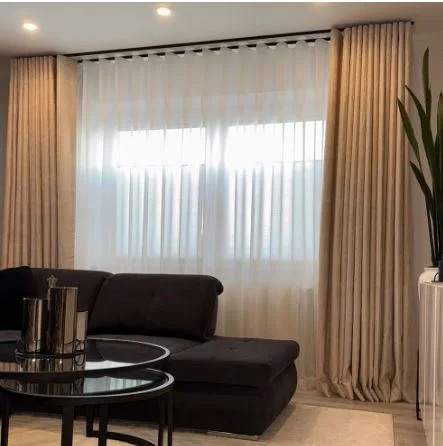Are Soundproof Curtains Effective?
Yes, soundproof curtains are indeed effective. However, it is important to understand what they can do and what they cannot do.
They can absorb sound very well within the room, which helps to reduce echoes and make the entire space sound quieter. They can also block some external noises. Depending on the material and installation method, the noise can be reduced by approximately 10 to 30 decibels.
But they are not a complete solution for soundproofing. Their effectiveness actually depends on many factors, such as the density and weight of the fabric, the thickness of each layer, and the installation method, etc. Even so, they cannot completely block all sounds—especially low-pitched sounds like traffic noise or bass-heavy parts of music.
So yes, they do help and can produce significant effects, but they are far from as good as true soundproofing. True soundproofing requires a completely sealed structure to prevent sound from entering or leaving the space.
What are “soundproof curtains”? Don’t be misled by the name
Most products labeled “soundproof curtains” are more accurately described as noise-reducing or sound-absorbing curtains. They don’t create an impenetrable barrier to sound like a thick wall or a professionally built sound booth. Instead, they:
- absorb some sound (especially mid and high frequencies),
- reduce echoes and reverberation inside the room, and
- partially block sound from passing through windows.
So, don’t expect silence—expect a quieter, less “harsh” room.
Noise blocking vs noise reducing: what’s the difference?
There are two related but different goals when you talk about controlling sound:
- Soundproofing — physically preventing sound from entering or leaving a space (think heavy walls, double-glazed windows, or dedicated isolation structures).
- Noise reduction / absorption — reducing the loudness inside a space and soaking up reflections so things sound less loud and less echoey.
Soundproof curtains mostly do the second job and partially help the first. That’s why they’re great when you want improvement without structural changes.
Why do they actually work? The simple acoustics behind it
There are three practical reasons soundproof-style curtains make a difference:
Density and mass: heavier fabrics block more sound
One simple acoustic rule is: the heavier and denser a material, the better it resists sound transmission. Thin, lightweight curtains let sound pass through easily. Thick, dense materials (heavy weaves, mass-loaded layers, or added filler) give the curtain mass that helps block sound waves from passing straight through.
Multiple layers reduce transmission and absorb energy
A curtain with several layers—a decorative outer fabric, a dense middle layer, and an inner backing—creates a barrier where each layer either reflects or absorbs parts of the sound. The small air gaps between layers and the different material behaviors help dissipate the sound energy so less reaches the other side.
Absorption lowers reflections and inside noise level
Even if external noise still gets in, a curtain that absorbs sound will reduce the room’s echo and reverberation. That makes the room feel quieter and less aggressive to your ears—not because all sound is gone, but because the annoying reflections are tamed.
What kind of improvement can you expect in real life?
Real-world gains depend on your starting point (how loud your environment is) and the curtain’s quality. Typical numbers you’ll hear: about 3–12 dB reduction in perceived noise level in many setups.
That range may sound modest, but remember: a 10 dB reduction is roughly perceived as cutting the loudness in half by human ears. So even a few decibels can be noticeable—especially when the noise moves from irritating to manageable.
Types of noise curtains reduce well
- Human voices and conversations
- TV sound / neighbors talking
- High-frequency and mid-frequency street noise (brakes, voices, small vehicles)
- Wind noise and rustling
- Room echo and reverberation
Types of noise they struggle with
Low-frequency sounds—big trucks, subwoofers, trains, and building vibration—are hard to stop with curtains. Those sounds have long wavelengths that pass through most soft materials and small gaps. If a heavy truck rumbles by, a curtain alone will usually make only a minor dent in the disturbance.
How do they compare to other noise-control options?
Versus standard heavy curtains
Not all heavy curtains are created equal. Specially-built “soundproof” curtains are heavier and often multi-layered compared to regular blackout or heavy decorative curtains. A random thick curtain may help a little, but dedicated noise-reducing curtains are usually more effective.
Versus sealing gaps (weatherstripping)
Sealing gaps around windows and doors actually addresses a key path for noise to enter. For the best result, pair sealed gaps with thick curtains. Sealing + curtains = far better outcome than curtains alone.
Versus acoustic panels
Acoustic panels are great for absorbing reflections inside a room (for example, in a music room or podcasting area), but they won’t stop external noise coming through windows. Curtains help with external noise and also reduce internal echoes—so they’re more versatile for many living spaces.
Versus double/triple-glazed windows
Double-glazed windows are a structural, permanent solution and usually outperform curtains at blocking outside sound—especially low-frequency noise. Still, they’re costly and require installation. Curtains are a budget-friendly, no-construction option that provides meaningful improvement quickly.
Recommended Materials and Types for Soundproof Curtains
Velvet Curtains
Velvet is one of the most effective fabrics for reducing noise. Its dense, heavy weave naturally absorbs sound waves, making it ideal for living rooms, bedrooms, or any space where echo is a problem. Thick velvet curtains not only block mid- and high-frequency sounds but also give a luxurious, elegant look to your room.
Blackout Curtains
While primarily designed to block light, high-quality blackout curtains also provide moderate sound absorption. Look for versions that combine a thick, tightly woven fabric with a thermal or foam backing layer—these can reduce outside noise and help create a quiet, cozy environment for sleeping or watching movies.
Layered or Multi-Ply Curtains
Multi-layer curtains are another excellent choice for sound control. They usually combine an outer decorative fabric with a dense middle layer, sometimes including mass-loaded vinyl or acoustic batting, and a soft inner lining. This combination helps block more noise than a single-layer curtain and is especially effective for urban apartments or rooms facing busy streets.
Linen and Polyester Blends
Lightweight fabrics like linen alone are not great for noise reduction, but blended polyester-linen curtains with added weight or a dense backing can provide moderate sound dampening while keeping a more airy, casual aesthetic. These are suitable for home offices or dining rooms where you want both style and mild noise reduction.
Custom Soundproof Curtains
As a professional curtain tailor, I recommend considering custom-made curtains if noise reduction is a priority. This allows you to choose the perfect combination of fabric weight, layers, lining, and length for maximum sound absorption, tailored specifically to your room’s size, window type, and interior design.
Hidden perks: it’s not just about sound
Thermal benefits
Thick curtains also help with insulation. In winter they can reduce heat loss, and in summer they block out some solar heat—so you might save a bit on your energy bill.
Privacy and light control
They’re usually blackout or nearly opaque, so they give you both visual privacy and reduced light, which is great for bedrooms and media rooms.
Better media listening
When echoes and reflections are under control, movies and music sound fuller and more pleasant—your living room instantly feels more like a small cinema.
Limitations and common misconceptions
They are not a substitute for structural soundproofing
If you need professional-level isolation (studio-level recording, total cut-off from city noise), curtains alone won’t do it. For that you need heavy construction: insulated windows, mass-loaded barriers, decoupled walls, etc.
They can’t fully block very loud, low-frequency sounds
If your environment is dominated by low bass rumbles, the curtain will help a little but will not make them disappear. Those require mass and airtight seals to control.
Cheap curtains are often worthless for noise control
Thin, flimsy curtains, even if labeled “soundproof,” will perform poorly. Weight, layers, and real acoustic backing matter—don’t buy on label hype alone.
How to tell if a curtain is actually good for noise reduction
1. Feel the weight
Pick it up. Heavy curtains usually mean higher mass per area, which helps block sound. If it’s light and airy, it won’t do much.
2. Look for multiple layers or dense backing
The best options have an outer decorative layer, a dense middle layer (sometimes with sound-absorbing fiber), and a backing layer—often blackout or thermal fabric. That sandwich structure is what makes the difference.
3. Check for acoustic ratings when available
Some products provide lab numbers: STC (Sound Transmission Class) or NRC (Noise Reduction Coefficient). Higher numbers are better. Many consumer curtains won’t have lab ratings, but if they do, that’s useful data.
Bottom line: are they worth it?
Yes—if your goal is to make your living space noticeably more pleasant without major renovations, sound-reducing curtains are a high-value, low-hassle option. They:
- reduce mid/high-frequency noise,
- dampen room echo,
- block light and improve privacy, and
- often help with insulation.
They’re not a one-stop solution for severe, low-frequency problems, but for most people who want fewer distractions and better sleep, they’re a smart buy.
Practical expectations and a simple plan
If you’re considering soundproof curtains, here’s a quick checklist to get realistic expectations:
- Decide your goal: reduce echo, block casual noise, or dramatically cut outside traffic sound?
- If your problem is echo or mid/high noise, curtains alone will likely be enough.
- If you have heavy low-frequency noise, pair curtains with sealing gaps or consider glass/window upgrades.
- Buy heavy, multi-layered curtains rather than the cheapest option.
For a hassle-free, professional solution, I highly recommend checking out UniCurt Curtains. They specialize in fully custom-made curtains tailored to your windows and style, and they offer global free shipping. With UniCurt, you can select the fabric, weight, layers, and design that match both your soundproofing needs and interior décor. It’s a convenient way to get high-quality, effective soundproof curtains without worrying about installation or shipping.
FAQ — Frequently Asked Questions
1. Can soundproof curtains completely silence my room?
No. They’ll reduce noise and tame echoes, but they won’t create full silence or replicate professional soundproofing. Expect improvement, not perfection.
2. Are thicker curtains always better?
Generally yes, but the trick is density and multi-layer construction, not just thickness. A heavy, dense fabric with acoustic backing beats a bulky but low-density fabric.
3. Will they help me sleep if I live near a busy street?
They can help a lot with window-level noise and reduce light, which helps sleep. However, very loud or low-frequency traffic might still be heard—curtains will make things significantly better, but not necessarily perfect.
4. Do they work better with other measures?
Yes. Curtains plus sealing gaps (weatherstripping) and sensible furniture placement (bookshelves, rugs) yields the best, affordable results. Each measure chips away at the problem in a different way.
5. Soundproof curtains vs acoustic foam—what should I choose?
It depends on the problem. Acoustic foam is designed to control reflections and is useful in studios or for reducing echo. Curtains are more practical for blocking outside noise through windows and improving general room comfort. For many home setups, both together are useful: foam for sound inside the room, curtains for outside noise and insulation.






